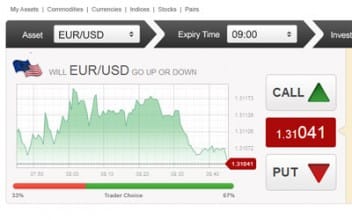Yesterday, we explained the two main types of traditional call/put options for forex trading. Today, we are going to look at the other category of FX options – namely Single Payment Options Trading, or SPOT for short.

Basically, SPOT trades automatically pay out when the option trade is proved successeful. This makes them very easy to trade – all you need to do is enter a scenario and let it play out. If it turns out that you called it right, you will make a profit on the trade, and cash will be entered into your account. If you got it wrong, you would lose your premium (the cost of purchasing the option) but nothing else. Unlike cash forex trades, there is no need to set stop losses, as you can only lose the premium attached to the option.
One of the main advantages of SPOT options is the flexibility that they offer, in terms of providing a variety of scenarios to the trader, to allow them to choose exactly what they think is going to happen. These include:
One-touch SPOT – Pays out if the price touches a certain level.
No-touch SPOT – Pays out if the price doesn’t touch a certain level.
Digital SPOT – Pays out if the price is above or below a certain level.
Double one-touch SPOT – Pays out if the price touches one of two set levels.
Double no-touch SPOT – Pays out if the price doesn’t touch any of the two set levels.
Of course, there is a slight downside to SPOT options, in that SPOT premiums are usually a bit more expensive than traditional options. You have to decide, as a trader, whether the benefits of SPOT options justify the extra cost, or if you could achieve the same net result with a cheaper traditional FX option.
Tradersdna is a leading digital and social media platform for traders and investors. Tradersdna offers premiere resources for trading and investing education, digital resources for personal finance, market analysis and free trading guides. More about TradersDNA Features: What Does It Take to Become an Aggressive Trader? | Everything You Need to Know About White Label Trading Software | Advantages of Automated Forex Trading









































